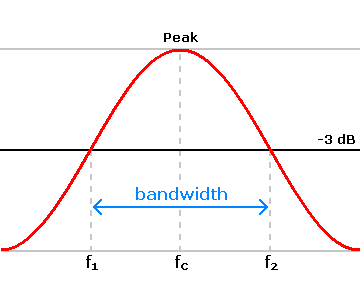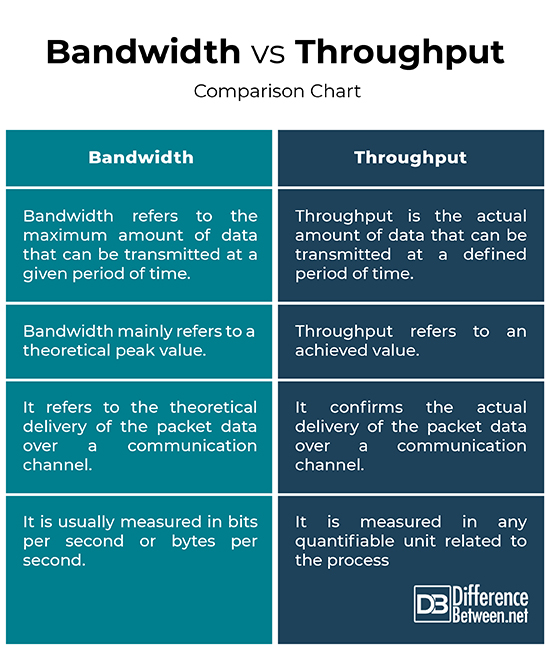Difference Between Bandwidth and Throughput
There are two transmission characteristics often discussed by networking professionals that are as important when measuring the capacity of a wired or wireless network communications. Bandwidth is a common term that is thrown around a lot by people who don’t really understand what the term actually means. Bandwidth is somewhat related to the Internet speed. Theoretically, bandwidth is the potential for data to transmit during a certain period of time. It is concerned with the transformation of information by some means. Throughput is yet another term related to the Internet speed which is concerned with communication between two entities.
Well, how both the terms are related and what is the difference between the two? Are they same? Both the terms are often confused with each other, but may be used interchangeably depending on the situation. Both bandwidth and throughput are rate metrics used to measure network performance. Bandwidth mainly refers to a theoretical peak value, while throughput refers to an achieved value. In a case, where the speed of both the interfaces and the communications medium is the same, and if the sender sends constantly, then the bandwidth is the same as the throughput. We take a look the difference between the two to understand how the two terms are used to measure network speed.
What is Bandwidth?
Bandwidth is a theoretical value that refers to the maximum amount of data that can be transmitted from point A to point B at a given period of time. It is the theoretical potential for data to transmit during a defined period of time. It is a performance metrics used to measure the transmission capacity over a network communication system. In terms of computer network, bandwidth refers to how many bytes of data are transmitted in a certain period of time. In digital world, web host packages include bandwidth allowance for each month, which is the maximum limit you can achieve in a month. Think of it as free minutes on your cell phone package, and if you go over allotted bandwidth limit, you’ll have to pay extra for the additional data transferred over the network.
What is Throughput?
Throughput is similar to but slightly different than bandwidth. Throughput is an achieved value that refers to the actual amount of data transmitted from point A to point B in a defined period of time. Unlike bandwidth, throughput is a performance metrics that refers to the actual speed of data on a network communication system. It refers to the performance of computing tasks over a given period of time. In simple terms, throughput is the measure of actual rate at which data is transferred over to the destination successfully. It confirms the actual delivery rather than theoretical delivery of the packet data over a communication channel. The term is synonymous with digital bandwidth consumption. Throughput is usually measured in bits per second (bps).
Difference between Bandwidth and Throughput
Meaning
– Bandwidth refers to the maximum amount of data that can be transmitted from point A to point B at a given period of time. It is a performance metrics used to measure the transmission capacity over a network communication system. Throughput is similar to but slightly different than bandwidth. Throughput refers to the actual amount of data transmitted from point A to point B in a defined period of time. Bandwidth mainly refers to a theoretical peak value, while throughput refers to an achieved value.
Measure
– Bandwidth is simply a measure of highest possible number of data packets that can travel through a communication channel theoretically, while throughput is the measure of actual number of data packets that can get transmitted. As an analogy of a highway, bandwidth refers to the maximum number of vehicles that can get through the highway over a give time period. Throughput is the number of cars that can actually get through.
Unit
– Bandwidth is typically measured in bits per second or bytes per second, kilobits per second (Kbps), megabits per second (Mbps), or gigabits per second (Gbps). Throughput is measured in mostly bits per second, or in some cases, in any quantifiable unit related to the process. In networking, throughput is the number of information systems processed per unit of time. When representing different data quantities, a lowercase ‘b’ represents ‘bits’ whereas an uppercase ‘B’ means ‘bytes’.
Applications
– A residential broadband connection might be allowed for a maximum bandwidth of 10 Mbps, but the actual throughput can be lower. This is why Internet service providers often advertise speed “up to 10 Mbps”. A fast gigabit Ethernet achieves a throughput rate of 1 Gbps might require bandwidth transmission rate of 1.25 Gbps because of the overhead in Ethernet frames. Applications that require maximum throughput include telephone signaling, video conferencing, and online video streaming.
Bandwidth vs. Throughput: Comparison Chart
Summary of Bandwidth vs. Throughput
Theoretically, bandwidth is the potential for data to transmit during a certain period of time. It is concerned with the transformation of information by some means. Throughput, on the other hand, is quite similar to but slightly different than bandwidth and is concerned with communication between two entities. Bandwidth refers to a theoretical value whereas throughput refers to an actual achieved value. Both the terms are often confused, but may be used interchangeably depending on the situation. Besides, both are performance metrics used to measure the network performance.
- Difference Between Caucus and Primary - June 18, 2024
- Difference Between PPO and POS - May 30, 2024
- Difference Between RFID and NFC - May 28, 2024
Search DifferenceBetween.net :
Leave a Response
References :
[0]Image credit: https://commons.wikimedia.org/wiki/File:JPEG_compression_throughput.png
[1]Image credit: https://commons.wikimedia.org/wiki/File:Bandwidth.png
[2]Donahue, Gary A. Network Warrior. Sebastopol, California: O'Reilly Media, 2011. Print
[3]West, Jill, et al. Network+ Guide to Networks. Boston, Massachusetts: Cengage, 2015. Print
[4]Cheng, John, et al. Professional CUDA C Programming. Hoboken, New Jersey: John Wiley & Sons, 2014. Print



